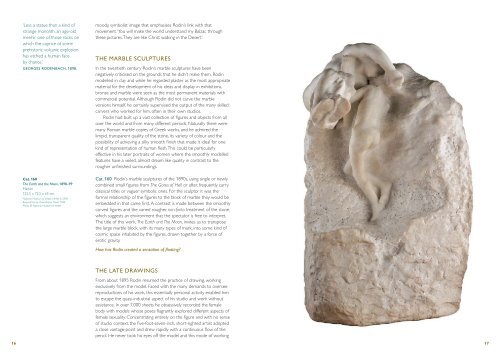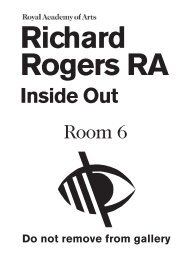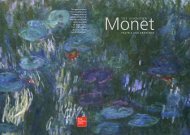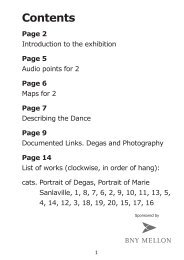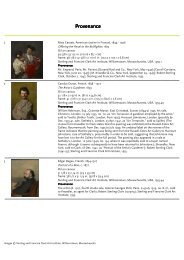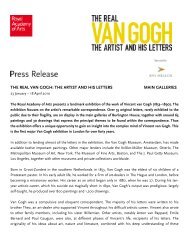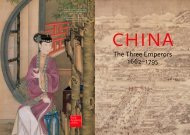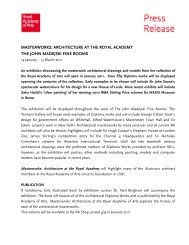rodin - Royal Academy of Arts
rodin - Royal Academy of Arts
rodin - Royal Academy of Arts
Create successful ePaper yourself
Turn your PDF publications into a flip-book with our unique Google optimized e-Paper software.
16<br />
‘Less a statue than a kind <strong>of</strong><br />
strange monolith, an age-old<br />
menhir, one <strong>of</strong> those rocks on<br />
which the caprice <strong>of</strong> some<br />
prehistoric volcanic explosion<br />
has etched a human face<br />
by chance.’<br />
GEORGES RODENBACH, 1898.<br />
Cat. 160<br />
The Earth and the Moon, 1898–99<br />
Marble<br />
122.5 x 72.5 x 65 cm<br />
National Museum <strong>of</strong> Wales, NMW A 2509.<br />
Bequeathed by Gwendoline David, 1940<br />
Photo © National Museum <strong>of</strong> Wales<br />
moody, symbolist image that emphasises Rodin’s link with that<br />
movement.‘You will make the world understand my Balzac through<br />
these pictures.They are like Christ walking in the Desert.’<br />
THE MARBLE SCULPTURES<br />
In the twentieth century Rodin’s marble sculptures have been<br />
negatively criticised on the grounds that he didn’t make them. Rodin<br />
modelled in clay and while he regarded plaster as the most appropriate<br />
material for the development <strong>of</strong> his ideas and display in exhibitions,<br />
bronze and marble were seen as the most permanent materials with<br />
commercial potential. Although Rodin did not carve the marble<br />
versions himself, he certainly supervised the output <strong>of</strong> the many skilled<br />
carvers who worked for him, <strong>of</strong>ten in their own studios.<br />
Rodin had built up a vast collection <strong>of</strong> figures and objects from all<br />
over the world and from many different periods. Naturally there were<br />
many Roman marble copies <strong>of</strong> Greek works, and he admired the<br />
limpid, transparent quality <strong>of</strong> the stone, its variety <strong>of</strong> colour and the<br />
possibility <strong>of</strong> achieving a silky smooth finish that made it ideal for one<br />
kind <strong>of</strong> representation <strong>of</strong> human flesh.This could be particularly<br />
effective in his later portraits <strong>of</strong> women where the smoothly modelled<br />
features have a veiled, almost dream like quality in contrast to the<br />
rougher unfinished surroundings.<br />
Cat. 160 Rodin’s marble sculptures <strong>of</strong> the 1890s, using single or newly<br />
combined small figures from The Gates <strong>of</strong> Hell or after, frequently carry<br />
classical titles or vaguer symbolic ones. For the sculptor it was the<br />
formal relationship <strong>of</strong> the figures to the block <strong>of</strong> marble they would be<br />
embedded in that came first. A contrast is made between the smoothly<br />
carved figures and the varied rougher, non-finito treatment <strong>of</strong> the stone,<br />
which suggests an environment that the spectator is free to interpret.<br />
The title <strong>of</strong> this work, The Earth and The Moon, invites us to transpose<br />
the large marble block, with its many types <strong>of</strong> mark, into some kind <strong>of</strong><br />
cosmic space inhabited by the figures, drawn together by a force <strong>of</strong><br />
erotic gravity.<br />
How has Rodin created a sensation <strong>of</strong> floating?<br />
THE LATE DRAWINGS<br />
From about 1895 Rodin resumed the practice <strong>of</strong> drawing, working<br />
exclusively from the model. Faced with the many demands to oversee<br />
reproductions <strong>of</strong> his work, this essentially personal activity enabled him<br />
to escape the quasi-industrial aspect <strong>of</strong> his studio and work without<br />
assistance. In over 7,000 sheets he obsessively recorded the female<br />
body with models whose poses flagrantly explored different aspects <strong>of</strong><br />
female sexuality. Concentrating entirely on the figure and with no sense<br />
<strong>of</strong> studio context, the five-foot-seven-inch, short-sighted artist adopted<br />
a close vantage-point and drew rapidly with a continuous flow <strong>of</strong> the<br />
pencil. He never took his eyes <strong>of</strong>f the model and this mode <strong>of</strong> working<br />
17


